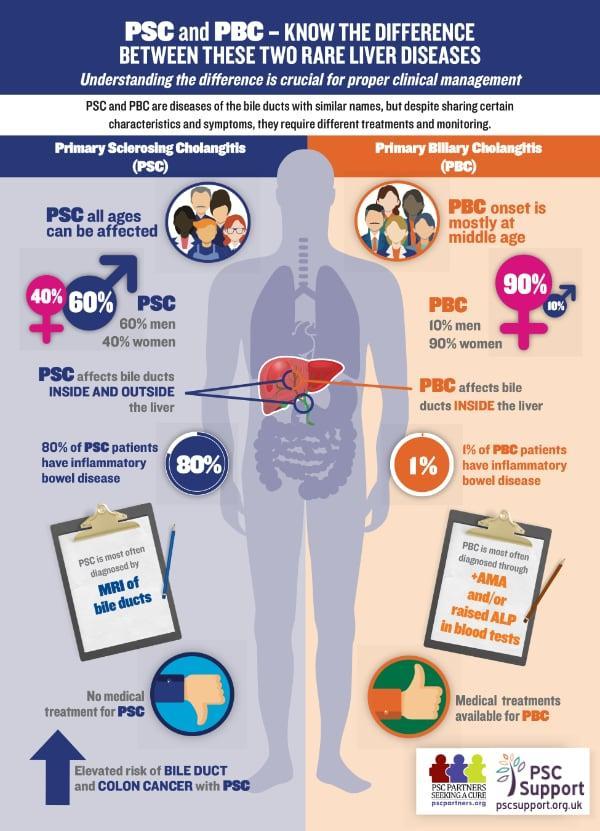Primary Biliary Cholangitis
PBC and PSC: What are the differences?
Know the difference between the two rare liver diseases, PSC and PBC
Primary sclerosing cholangitis (PSC) is part of the family of 'cholestatic liver diseases' 4. This means it is a disease that affects the bile ducts - tubes that deliver bile from the liver to the small intestine.
PSC occurs because of inflammation in the bile ducts (cholangitis), which results in hardening (sclerosis) and narrowing of the ducts 1. As a result, bile cannot be released properly and it builds up in the liver where prolonged exposure results in liver damage.
The medical abbreviation for primary sclerosing cholangitis is PSC. Although medical abbreviations are designed to simplify disease names, they can sometimes cause confusion; particularly as other liver conditions incorporate similar names. Another closely related condition that you may have heard of is PBC (originally called primary biliary cirrhosis, recently renamed as primary biliary cholangitis).
Quick Links

By contrast, PBC mainly affects the small bile ducts in the liver itself and is not associated with changes in the large bile ducts of the liver and therefore the bile ducts appear normal on an MRI scan 50 In the current era, PBC can be identified through special antibody tests (performed on blood sampling) and liver biopsy is rarely needed.
Unlike PSC, PBC does not share an association with IBD, colonic cancer or bile duct cancer; however people with PBC with advanced disease can develop liver cancer (HCC), similarly to people with liver cirrhosis from other causes. Individuals with PBC can occasionally develop thyroid problems, dry eyes (a condition called 'Sicca syndrome/Sjogren's syndrome) or intolerance to gluten in wheat (coeliac disease) 51. It's important to note that people with PSC can also develop other immune-mediated attacks such as thyroid disease, coeliac disease and type 1 diabetes.
It is important to recognise that PBC and PSC are different diseases; stemming from the way they are diagnosed, the association with IBD, and the way they are monitored and respond to treatment. The layers of complexity in PSC require the care of clinicians experienced in treating PSC and knowledge of current PSC research.
(Table 1 updated 7 February 2019)
| Feature | PSC - primary sclerosing cholangitis | PBC - primary biliary cholangitis |
|---|---|---|
| Site of disease involvement | Bile ducts inside and outside the liver; however in small duct PSC (10-15% of patients) only the small ducts inside the liver are affected | Small bile ducts inside the liver only |
| Mode of diagnosis | Usually by MRI of bile ducts. Occasionally liver biopsy or ERCP is needed | Two of the following:
|
| Associated with increased risk of bile duct and colon cancer | Yes | No |
| Response to Ursodeoxycholic acid (UDCA) | Improves liver blood tests in some patients; not conclusively proven to slow disease progression | Associated with improved prognosis in those individuals who respond well to UDCA |
| Co-existing inflammatory bowel disease (IBD) | Around 80% of patients have IBD - mostly colitis | Very rare and not characteristic; around 1% |
| Common symptoms in early disease | Itching, fatigue, abdominal pain, bacterial cholangitis | Itching, fatigue, dry eyes and mouth, abdominal pain |
| Gender predominance | 60% men, 40% women | 90% women, 10% men |
| Average age at diagnosis | Any age; mostly around 40 years | 75% are affected in middle age (>45 years old) |
| Associated with excess alcohol consumption? | No | No |
| Associated with smoking | Most often non-smokers | Associated with a history of smoking 76,77 |
